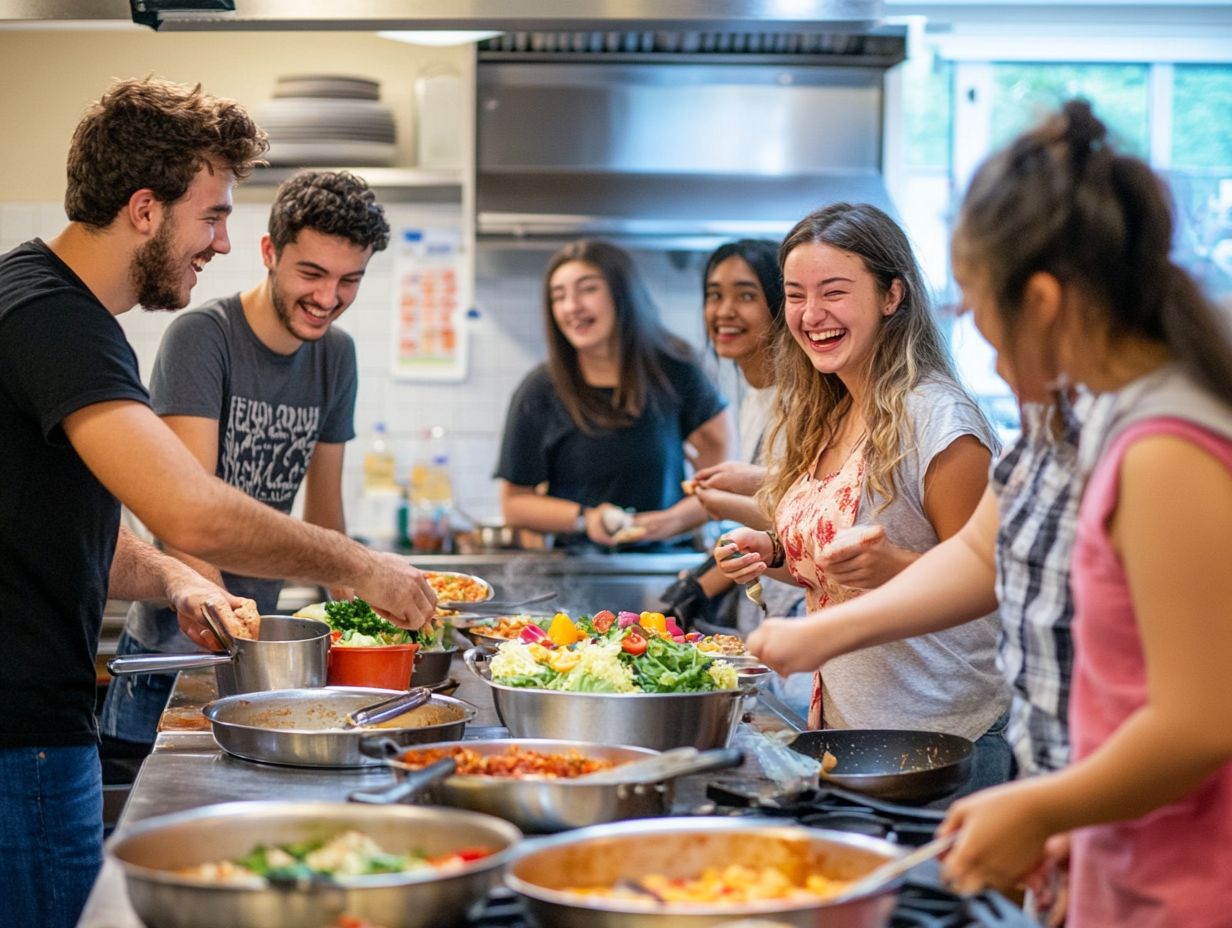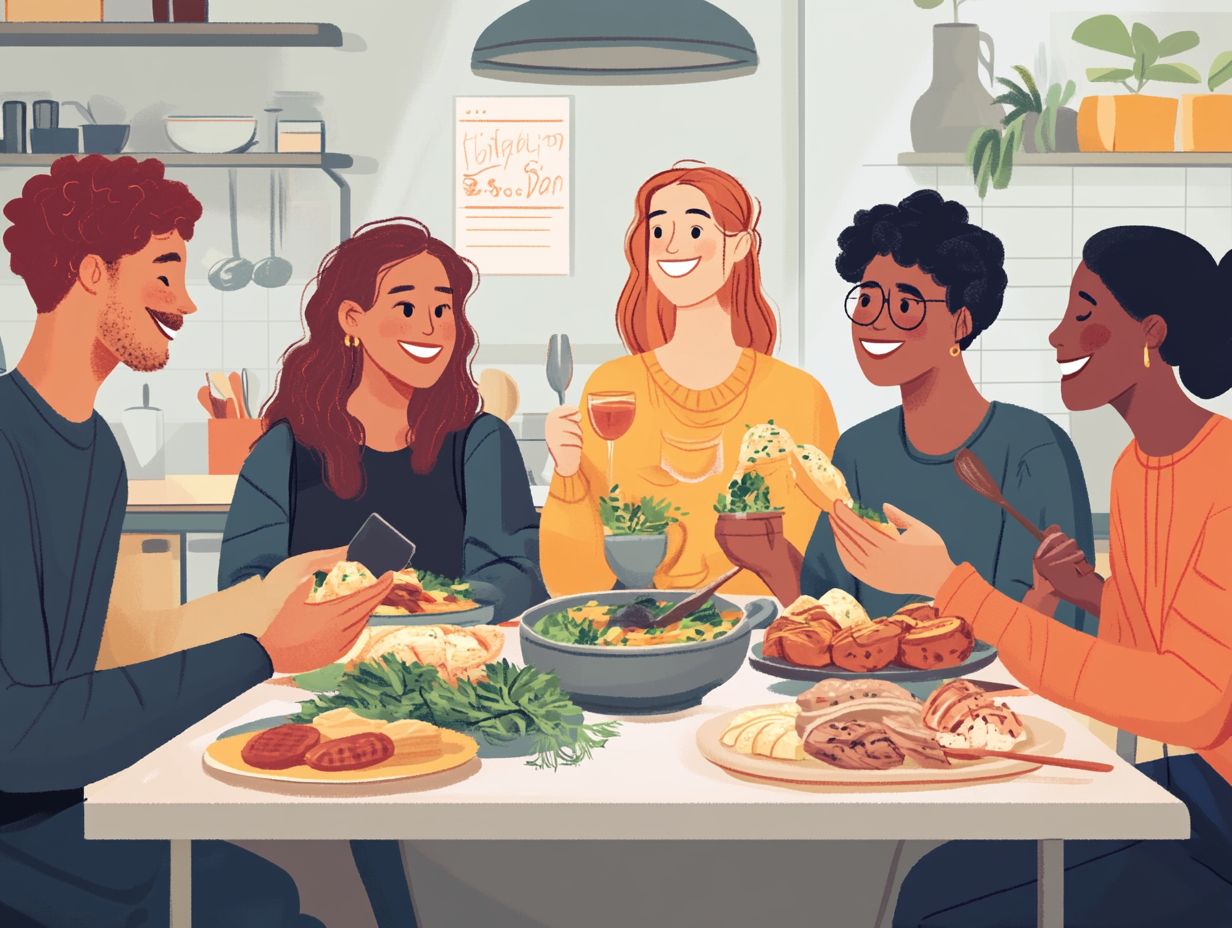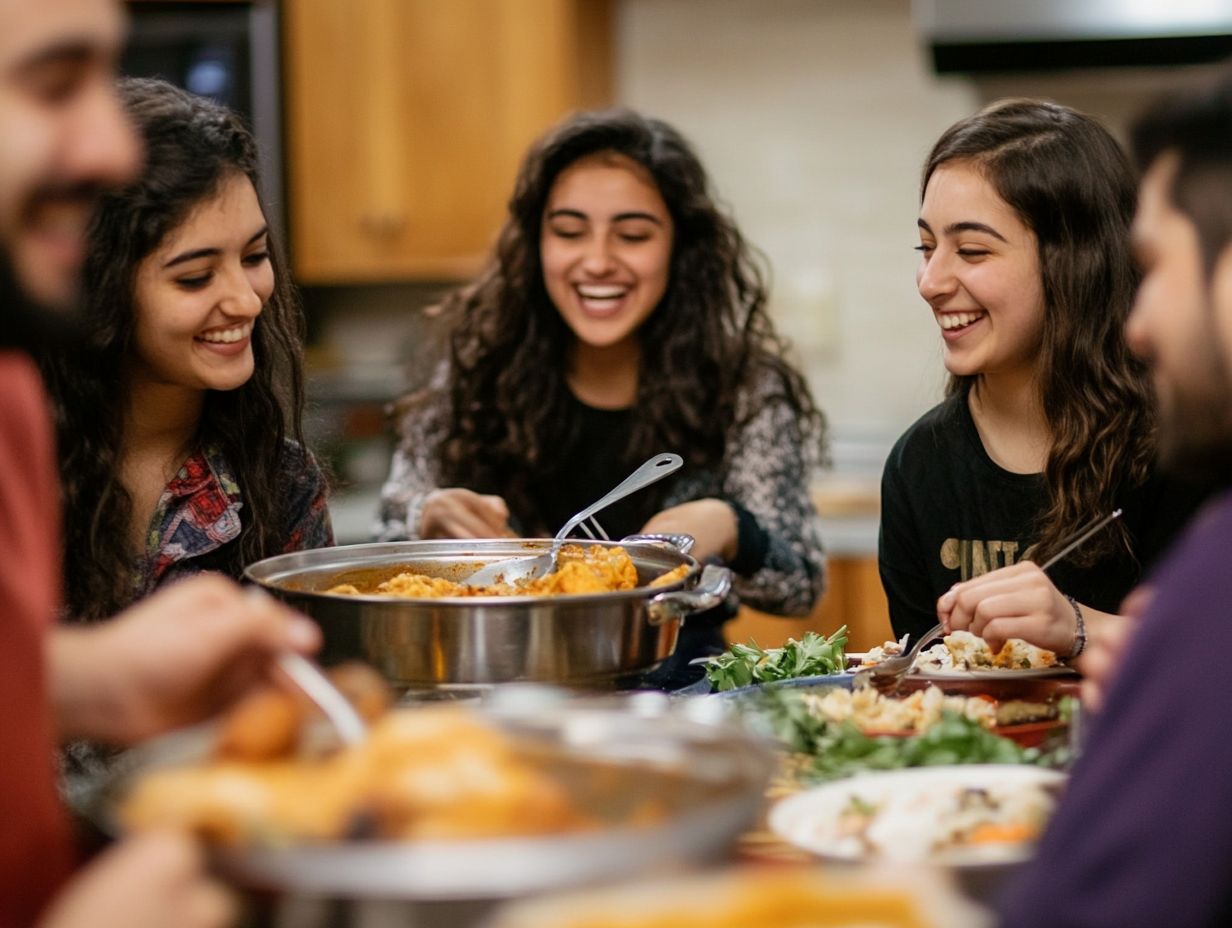Adapting to Local Cuisine: Tips for Students
Navigating a new culinary landscape is an exhilarating yet challenging journey for students. Understanding cultural nuances of food enriches your palate and elevates your experience in a fresh environment.
This article explores diverse flavors and ingredients you’ll encounter, offers practical tips for sampling new dishes, and addresses common hurdles such as food allergies and homesickness.
Whether you re a picky eater or a curious adventurer, you will discover that embracing new culinary experiences fosters personal growth and creates unforgettable memories.
Contents
- Key Takeaways:
- Why is it Important for Students?
- Understanding Cultural Differences in Food
- Tips for Trying New Foods
- Navigating Food Allergies and Restrictions
- Finding Familiar Foods
- Embracing New Culinary Experiences
- Frequently Asked Questions
- What is local cuisine?
- Why is it important for students to adapt to local cuisine?
- How can students adapt to local cuisine?
- Are there any potential challenges in adapting to local cuisine?
- How can students ensure they are eating safe and hygienic local food?
- What are the benefits of adapting to local cuisine?
Key Takeaways:

- Embrace new culinary experiences! Try different flavors and ingredients to expand your palate and cultural understanding.
- Communicate your food allergies and restrictions with restaurant staff for a safe dining experience.
- Overcome fear and discomfort when trying new foods. Be open-minded and start with small portions. Find familiar foods to ease homesickness.
Why is it Important for Students?
For students, studying abroad is more than just academics; it’s an exciting opportunity to dive into a rich tapestry of culinary traditions. Exploring local cuisine in Italy helps you understand the culture better and makes you more adaptable while forging lasting memories around shared meals.
As you explore unfamiliar territories, you will discover the vibrant flavors of Costa Rican dishes and the hearty staples of Irish cuisine. These experiences enrich your palate and enhance social interactions, helping you overcome language barriers and embrace meal customs that differ from your own.
Understanding Cultural Differences in Food
Understanding cultural differences in food is essential when studying abroad. Local cuisine embodies the history, values, and customs of the destination country. Each dish, from Costa Rican flavors to comforting Irish fare, tells a story rooted in tradition.
Consider enrolling in cooking classes to appreciate the cultural subtleties involved. This enhances your adaptation experience and fosters a deeper connection with the local community.
Exploring Different Flavors and Ingredients
Exploring new flavors and ingredients is essential to your experience of trying new foods while studying abroad. You might delight in fresh local ingredients like Spanish red beans and atole in Costa Rica, while in Ireland, you could enjoy rich stews and traditional baked goods.
Your journey brings you to vibrant local markets! Here, you can engage with vendors and uncover the significance of these ingredients within your new culinary landscape.
The lively markets in both regions serve as a melting pot of flavors, highlighting the contrast between Costa Rican staples like fresh tropical fruits and hearty Irish dishes filled with root vegetables, grains, and seafood. Connecting with local farmers and artisans deepens your understanding of how regional climates and cultures shape culinary traditions.
For instance, a Costa Rican casado elegantly showcases a balance of proteins and vegetables, enhanced by the freshness of cilantro and lime. An Irish colcannon combines creamy potatoes with kale or cabbage, embodying comfort and nourishment in simpler cooking.
Each bite delivers a delightful flavor experience and tells a rich story of community and heritage.
Tips for Trying New Foods
Exploring new foods while studying abroad can be exhilarating and somewhat intimidating. Equip yourself with practical tips from understanding local customs to elevate this experience immensely.
Prioritize food safety and make informed dining choices. Identify recommended restaurants that serve authentic local cuisine for a delightful introduction to unfamiliar dishes.
Immerse yourself in local food festivals! They offer a fantastic opportunity to savor a variety of flavors and dishes in a vibrant, communal setting.
Don t miss out! Sign up for a cooking class and discover the joys of local cuisine today!
Overcoming Fear and Discomfort

Overcoming fear and discomfort when faced with unfamiliar foods is essential for your culinary journey while studying abroad. You will encounter dishes that might challenge your taste buds, and learning how to celebrate local traditions as a student can enhance your experience. Embracing these moments can lead to personal growth.
Engaging in communal eating experiences can help alleviate fears. Sharing meals with locals breaks down barriers and fosters connections that enrich your understanding of food customs.
As you dive into new flavors, it s natural to feel anxious about taste or dietary preferences. Participating in group dining experiences allows you to discover the joy of shared culinary adventures while feeling more at ease.
Communal meals create a sense of belonging. You can approach each dish with curiosity rather than apprehension. Sharing stories around the table deepens connections and transforms you from an apprehensive eater into an enthusiastic explorer of local cuisine. This shared experience turns what once felt intimidating into a delightful celebration of new flavors and friendships.
Strategies for Picky Eaters
Navigating the vibrant culinary landscape while studying abroad might feel daunting for picky eaters. However, effective strategies can elevate your food experiences. Seeking out vegetarian options or familiar street food can serve as a comforting gateway into local cuisine, and knowing cultural etiquette tips for international students can enhance your interactions while exploring new flavors.
This allows you to explore new flavors at your own pace. Utilizing resources like food blogs and local recommendations can guide you toward dishes that align with your preferences.
Gradually expanding your palate is crucial. Start with milder flavors or familiar textures to ease the transition and quell any apprehension.
Visiting local markets offers the chance to sample small portions of various dishes. This minimizes waste and avoids the pressure of committing to full meals that may feel intimidating.
Engaging with local chefs or food enthusiasts enriches your understanding of the cuisine. It facilitates an explorative journey while honoring your dietary choices.
Navigating food allergies and dietary restrictions is crucial for indulging in a culinary adventure while studying abroad. It requires clear communication and thorough preparation.
Articulating your needs effectively to restaurant staff ensures your meals are safe and in harmony with your dietary preferences. Understanding how local cuisine accommodates food allergies enables you to explore diverse culinary experiences without compromising your health.
Communicating with Restaurant Staff
Communicating effectively with restaurant staff is crucial for students with food allergies, especially when language barriers complicate the dining experience. Mastering key phrases in the local language facilitates clearer discussions about dietary restrictions, ensuring safe meal preparation.
Whether in the bustling food markets of San Jose or the quaint eateries of Cork, being proactive about communication helps you navigate unfamiliar menus with confidence.
If you have a nut allergy, memorizing phrases like, “Does this contain nuts?” or “Please prepare my dish without peanuts” can significantly reduce misunderstandings. One student shared a positive experience where they clearly communicated their gluten allergy. The chef went the extra mile to create a customized dish, turning potential anxiety into pure satisfaction.
Displaying an allergy card in the local language can be a lifesaver. This ensures that even if verbal communication falters, the staff is informed about your critical dietary needs.
Don’t hesitate! Try that strange-looking dish and share your stories with fellow students!
Finding Familiar Foods
Discovering familiar foods while studying abroad can be a source of comfort. It eases homesickness and facilitates a smoother transition into a new culture.
You might find yourself exploring local markets that offer ingredients or dishes reminiscent of your home cuisine. This allows you to maintain a connection to your roots.
Whether it s a flavor that evokes memories of Costa Rican dishes or a taste inspired by Irish cuisine, these familiar delights can act as a bridge between cultures. They enrich your overall culinary experiences.
Options for Homesickness

When homesickness strikes, comfort food can provide solace. It makes studying abroad feel more like home.
Whether you discover a caf that serves traditional Irish stew or a restaurant specializing in Costa Rican atole, these culinary experiences remind you of home while inviting you to explore local cuisine.
Engaging with local markets to recreate familiar dishes also serves as a therapeutic outlet. It brings a taste of home into your new surroundings.
For those missing the flavors of home, something as simple as whipping up spaghetti and meatballs can be both satisfying and nostalgic. Picture yourself in a shared kitchen, chopping onions and mixing ingredients. It sets the perfect stage for lively conversations and bursts of laughter.
These cooking sessions create delightful meals and more. They foster friendships as you share stories and traditions behind each recipe.
The joy of savoring homemade mac and cheese or aromatic chicken curry can bridge cultural gaps. You bond over the universal language of food.
Ultimately, these experiences redefine comfort food. They craft new memories while honoring the cherished ones from your past.
Embracing New Culinary Experiences
Embracing new culinary experiences while studying abroad can profoundly transform your journey. It enhances both your palate and cultural awareness.
Food festivals offer a lively gateway into local cuisine. They invite you to savor traditional dishes and connect with locals who share your enthusiasm for food.
Engaging in these delightful experiences helps you adapt to your new surroundings. It fosters a richer appreciation for cooking skills and the unique stories woven into each dish.
Benefits of Trying New Foods
The benefits of trying new foods while studying abroad go well beyond satisfying your taste buds. They foster community bonding and help you adapt to unfamiliar environments.
Engaging with local cuisine creates connections with peers and locals. These shared experiences deepen your cultural understanding.
As you embrace diverse flavors and culinary traditions, you enrich your culinary adventures. You also develop essential life skills that will serve you long after your time abroad.
These culinary adventures spark flexibility! They nurture open-mindedness, traits crucial for navigating the complexities of life in a foreign country.
Sharing meals can break down barriers. It sparks conversations and friendships that may not have blossomed otherwise.
Each dish tells a story. It offers a window into the region s history and traditions, transforming the dining experience into a journey of learning and exploration.
By stepping outside your comfort zone to savor unfamiliar cuisines, you nurture a sense of curiosity and confidence. This enhances your overall educational journey, enabling you to face future challenges with an adaptable mindset.
Frequently Asked Questions
What is local cuisine?
Local cuisine refers to traditional food and dishes unique to a particular region or culture. It is an important aspect of a country’s identity and often reflects its history, climate, and available ingredients. Examples include Italian pasta or Thai curry.
Why is it important for students to adapt to local cuisine?

Adapting to local cuisine allows students to fully immerse themselves in the culture. It helps them experience the authentic flavors of a new place and save money by avoiding expensive international food options. For more insights on this transition, consider exploring navigating cultural shock.
So, don’t hesitate! Dive into new flavors and create unforgettable memories while you study abroad!
What comfort food do you miss most? Share your favorites!
How can students adapt to local cuisine?
Students can adapt to local cuisine by being open-minded and trying new foods. Exploring local flavors can be even more rewarding with a student’s guide that helps you research beforehand and ask locals for recommendations.
Are there any potential challenges in adapting to local cuisine?
Challenges may include language barriers and unfamiliar ingredients. However, these can also be opportunities to learn and improve cooking skills.
How can students ensure they are eating safe and hygienic local food?
To eat safely, students should choose reputable restaurants and street vendors. They should also watch for hygiene standards and avoid raw or undercooked foods.
What are the benefits of adapting to local cuisine?
Adapting to local cuisine allows students to fully experience a new culture! It also supports local businesses and can lead to new taste preferences and skills to take home. Embrace these incredible flavors by exploring food culture: embracing local cuisine abroad!


![5 Best Weekend Getaways from [Your Study Location]](https://abroadfocus.com/wp-content/uploads/2024/09/5-best-weekend-getaways-from-your-study-location-xW-768x578.jpeg)

